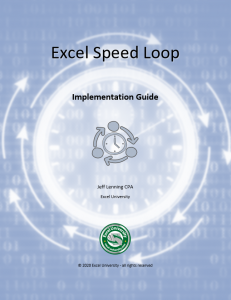How to Save Time in Excel with Speed Loop®
Efficiency became a necessity...
I used to be an accountant. That means I spent tons of time updating Excel workbooks from my cubicle.
The work wasn't bad - but, it was taking me weeks to complete projects that should have been finished way earlier. My work/life balance was suffering. I was constantly stressed out as deadlines started looming closer and closer.
The worst part is that my work didn't always stay in the office.
Since I was always stressed out and cranky about having more work than time, I wasn't able to enjoy my evenings and weekends.
I was working late nights and early mornings and felt overwhelmed every minute. At that point, I knew I needed to learn how to save time in Excel.
I developed an informal system and a variety of Excel skills that helped me get my work done faster. Then, I formalized the method (aka framework, approach, system, process, cycle), and named it the Speed Loop® method.
The Speed Loop® helped me complete two weeks of work in only two days.
This method is what I used to get my schedule under control, feel relaxed at work, and have a better work/life balance.
I teach this method for free, and I hope it can help you save time in Excel as well.
Learn How to Save Time in Excel in Three Steps

Part of successfully implementing the Speed Loop® is looking at your work as a whole, and identifying the parts of it that can be automated. This is done in three steps.
Invest Time
- Identify - recurring project workbooks
- Insert - lead sheets
Appreciate Assets
- Automate - manual tasks
- Anticipate - errors, and prevent and/or detect them
- Accumulate - Excel skills needed to automate tasks next period
Realize Gain
- Rebuild - the set of workbooks as a whole
- Reinvest - locate the next set of recurring project workbooks

Investor Mindset
I use an investor metaphor to teach the Speed Loop®. An investor makes a financial investment, hopes the asset appreciates in value, and expects to realize a gain upon sale. That is, the investor seeks to get more back than what was invested.
Here, we are investing time (a precious resource) and expecting to realize a gain (saving more time than we invested).
This investor mindset helps keep us focused on the task at hand: learning how to save time in Excel by improving our recurring-use workbooks and getting our work done faster each period.
"I was able use these concepts to reduce the time it took to prepare my financial dashboards from five days to 60 minutes. The key takeaway from the Speed Loop® was that building reports is a process and not just a deliverable."
- Excel University Student Larry
"I always learn something from Jeff Lenning. He knows so much about excel and is able to clearly & simply explain the different functions and how they can help you. Very systematic approach!"
- Course Participant Kathy
"This was a great webinar and Jeff was so easy to follow and listen to. His examples were simple, but I could easily think of ways to apply them to my everyday work. Thank you for sharing this valuable knowledge, Jeff!"
- Course Participant Elizabeth
Free Webinar
If you think the Speed Loop® could help, please register for my free pre-recorded webinar.
During the 45 minute webinar, we take a sample workbook and go through several automation steps:
- Converting ordinary ranges to tables
- Converting static values to formulas
- Converting formula-reports to PivotTables
- Converting manual copy/paste with Power Query
It is really fun and the details make the Speed Loop® more concrete and easier to visualize.
Speed Loop® Coaching Program
The Speed Loop coaching program is designed for folks who would like some hands-on assistance implementing it into their workbooks.
- We take your workbooks through the Speed Loop®
- 5 students per coaching team
- 5 team meetings
- MVPs have additional 1-on-1 meetings with Jeff
- Team discussion forums provided

